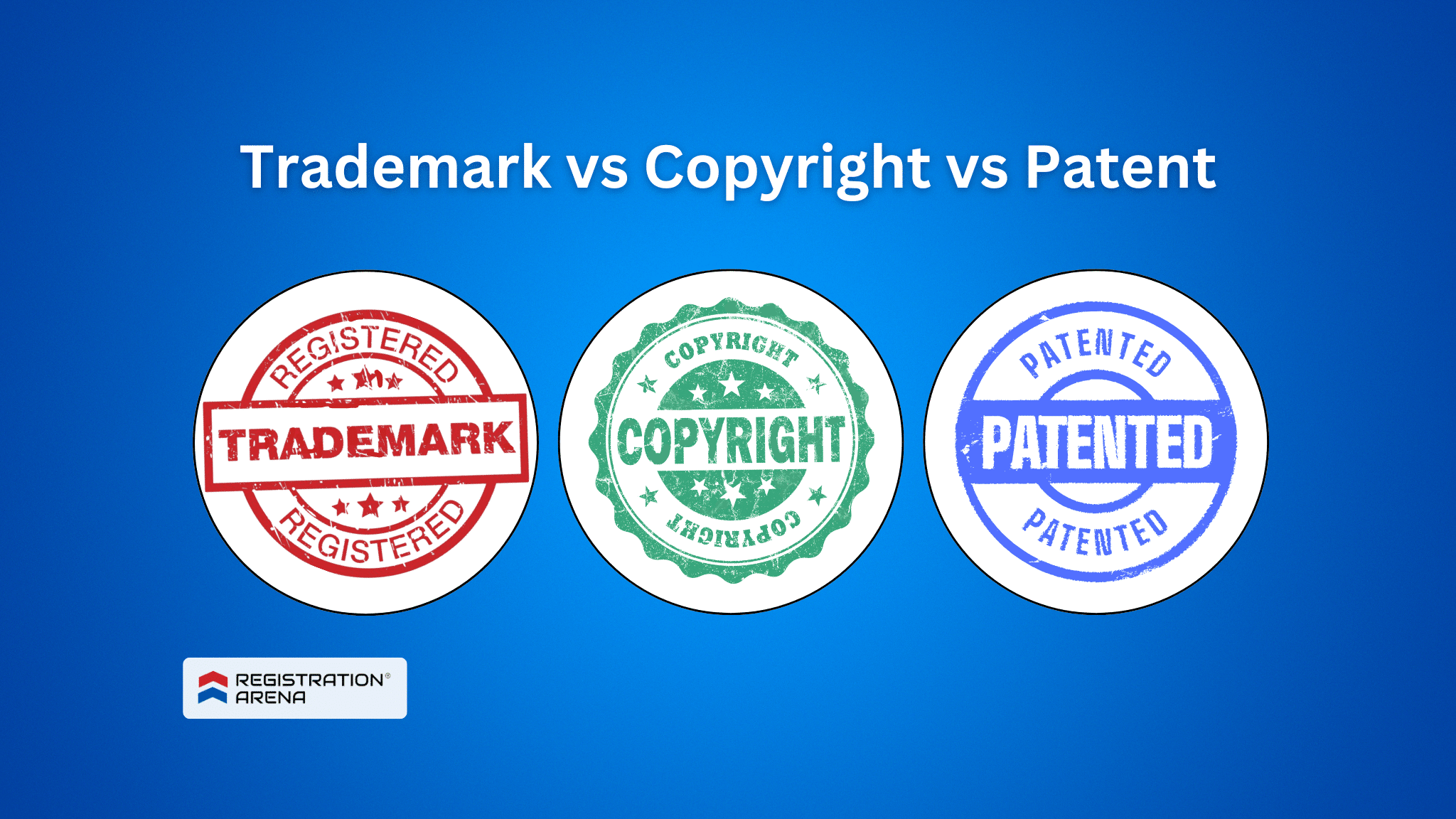
Trademark vs Copyright vs Patent
Trademark | Patent | Copyright | |
| What’s protected | Any word, phrase, symbol or design that recognizes and differentiates the source of one party’s goods from those of another. | Inventions, such as procedure, manufacturer, composition, machines of matter as well as improvements to these. | Books, articles, music, photography, sculptures, dances, sound recordings, motion films and other original works of authorship. |
| Requirements for protection | A mark must be distinguishable, in the sense that it must be able to identify the source of a certain good. | A fresh, valuable, and unusual invention is required. | A work must be unique, original, and created in a tangible manner. |
| Term of protection | As long as the mark is used in commerce. | 20 years | Author’s life span+ 70 years. |
| Rights Granted | Right to use the mark and to prohibit others from using identical marks in a way that could create confusion about the goods or services’ origin. | Right to restrict others from manufacturing, selling, or importing the patented invention. | Copyrighted works have the power to dictate their reproduction, creative works, circulation, public performance, and display. |
Trademark Objection FAQ’s
What is a trademark?
In India, a trademark can be a unique sign, image, or name that signifies who created a product or provided a service. It stands as a unique identifier for a business, showcasing its brand and quality. Registering a trademark grants exclusive rights to use it, preventing unauthorized usage by others.
Why is the trademark objection step crucial in India?
The trademark objection step is pivotal during the trademark registration process. It involves an officer meticulously checking the chosen brand name to ensure compliance with all rules. Objections indicate issues or conflicts, which need rectification for successful registration.
What are the primary steps for Trademark Registration in India?
Trademark registration involves:
- Trademark search
- Filing of trademark application
- Formality inspection
- Publication in the journal
- Grant of trademark registration
What happens if there’s a Trademark Objection?
Upon submitting a trademark application, it undergoes rigorous examination. If any inconsistencies or overlaps with existing trademarks are found, an objection is issued. It’s vital to note that an objection isn’t a denial but a request for clarification or adjustment.
Why do I need to pay trademark objection reply fees?
These fees cover the administrative costs of processing your reply and the jurisdiction in which the trademark application is filed. We offers exclusive and competitive pricing for responding to trademark objections.
What are objections under Section 11?
Section 11 objections relate to the similarity between the proposed trademark and existing ones. These can be due to identical marks, similar sounds, or shared concepts among trademarks.
What are objections under Section 9?
Section 9 deals with objections raised due to trademarks that are too descriptive, lack distinctiveness, or are potentially misleading to consumers.
How does one respond to trademark objections online?
If the trademark application fails to meet standards, a notification is sent to the applicant. They must respond within 30 days, addressing the concerns raised. Failure to satisfy the standards may result in application denial, though appeals can be made to the Intellectual Property Appellate Board.
What’s the difference between Trademark Objection and Trademark Opposition?
While the terms are sometimes used interchangeably, they are different. An “objection” relates to concerns raised by the reviewing officer about the registration process. In contrast, “trademark opposition” involves challenges by third parties disputing the trademark’s validity.
When should one submit the objection reply?
Upon receiving the examination report, it’s crucial to file a reply within 30 days, comprehensively addressing all queries raised.
What documents are needed for the reply note?
To effectively address objections, one should submit:
- Invoices and bills
- Affidavits
- Business cards and letterheads
- Relevant government documents, such as MSME or FSSCI certificates
- Screenshots of social media pages or advertisement copies
How should one respond to the Trademark Objection?
On receiving the examination report, a detailed written reply should be promptly submitted. This response should present justifications, evidence, and facts, asserting the mark’s eligibility for valid registration.
What are critical aspects to consider when crafting a reply?
Crafting a reply demands:
- Comprehensive objection analysis
- Adherence to the specified format
- References to applicable laws, prior rulings, and mark differences
- Including any supporting documents or evidence
- An affidavit if the trademark appears on digital platforms
What role does IndiaFilings play in the Trademark Objection process?
IndiaFilings offers expert guidance on trademark objections and end-to-end registration services. Their team specializes in addressing objections, ensuring responses are comprehensive, boosting the chances of successful trademark registration.
Why should I consider IndiaFilings for managing Trademark Objections?
IndiaFilings boasts expertise in the intricacies of trademark objections. By choosing them, you enhance your chances of navigating these challenges and securing your trademark with confidence.
Can a trademark application be denied?
Yes, if the applicant’s response to an objection doesn’t meet the expected standards, the application may be denied. However, the applicant can appeal against this decision.
How does one differentiate between identical and similar trademarks?
Identical marks are exactly the same, while similar trademarks might have differences in appearance, sound, or concept but can still cause confusion among consumers.
Why is a descriptive trademark objectionable?
Descriptive trademarks, like “FreshJuice” for juice products, directly describe the product. Such trademarks lack uniqueness, making them objectionable as they don’t distinctly identify the source of the goods or services.
What is the public’s role after the objection is addressed?
After addressing the objection, the trademark is listed in a public journal. The public then has four months to review and raise any opposition against it.
What happens if an objection isn’t addressed within the stipulated time?
If objections aren’t addressed within the provided timeframe, the trademark application may face rejection.









Average Rating